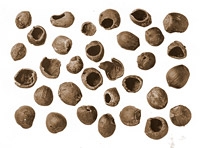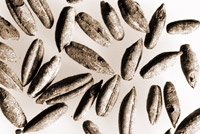Research project
Plant Macro-Fossils and Climate Change
This part of the research programme is carried out by Prof. Dr. René Cappers. It focusses on the continuities and changes in the use of plants at Late Neolithic Tell Sabi Abyad, as well as on their implications as proxy evidence for the climate change c. 6200 BC. Parallel to the design of the other subprojects, this project consists of three parts:
Analysis of new data
This is an archaeobotanical analysis of a large, representative number of plant samples from well-defined deposits of the early period of settlement at Tell Sabi Abyad, c. 6800-6200 BC. It is important to note that current knowledge on the use of plants in Syria in this period is very poor; in this respect the new plant record from Tell Sabi Abyad offers a unique opportunity to increase our insight. The generally excellent preservation of the samples allows the identification up to the level of species, which is a prerequisite for optimal interpretation. The plant records will be used for the reconstruction of the exploitation of plant resources, as well as the reconstruction of prehistoric agricultural practices and storage behaviour. The investigation will rely upon a new approach recently developed by the researcher (Cappers, in press a), including the combined analysis of plant remains in storage facilities, architectural features (e.g. mud bricks) and ash layers in order to determine both field-weed flora and agricultural practice. The analysis is based on the different processes by which the small and tall field weeds, as well as the seed bank of fields, are incorporated in particular archaeological contexts.
Integration with earlier work

The newly obtained results will be integrated with the previous archaeobotanical research at Tell Sabi Abyad (see e.g. Van Zeist & Waterbolk-Van Rooijen 1996; Van Zeist & De Roller 2000; Cappers, in press b). The already available plant records will be re-interpreted by determining their proxy information with regard to climatic change and specific environmental conditions. A similar approach will be applied to plant records derived from the new samples.
Climate research

This part of the project comprises specific research into the use of subfossil macro remains of both domesticated and wild plants as proxy evidence for the climate change at about 6200 BC, This proxy evidence will be inferred on three different levels.
First, the physiological adaptation to increasing drought is deduced from the characterization of the photosynthetic pathway of wild plant species (i.e. C3 and C4 pathway; see e.g. Batanouny et al. 1988).
Second, the proportion of barley to wheat will be estimated. Barley has a shorter life cycle and is mainly therefore less sensitive to drought. The quantification will be based on standardized counts of both grain kernels and rachis fragments (Cappers, in press).
Third, the ecological adaptation will be inferred from the use of fuel. The analysis of ash layers in particular will be used to determine the proportion of wooden plants (indicative of moist-wet conditions) to herbs (indicative of dry conditions). The decrease or even disappearance of trees and shrubs as sources of fuel may have been compensated by the production of dung-cakes, in which dung and threshing remains are mixed, and the exploitation of spiny herbs such as camel-thorn ( Alhagi graecoum) and Astragalus species.
The results of the macrobotanical analyses will be integrated with current palynological research in the region. Thus, it will be hopefully possible to integrate detailed information from the local vegetation, obtained through macro plant fossils, as well as from the regional vegetation, obtained through pollen analysis.
